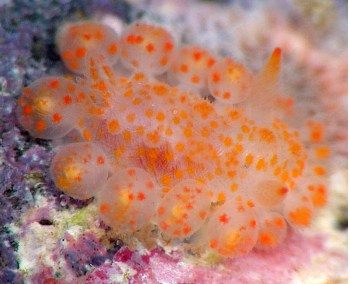
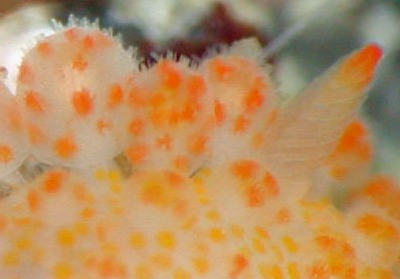
Limacia ornata
(Baba, 1937)
Order: NUDIBRANCHIA
Suborder: DORIDINA
Superfamily: ANADORIDOIDEA
Family: Polyceridae
Subfamily: Triophinae
DISTRIBUTION
Japan, Australia (east and west coasts)
PHOTO
Osezaki Suruga Bay, Japan, 2 Jan 2003. Size approx: 5mm, Depth: 2m. Lower photo showing spiculate nature of stalked spherical tubercles. Photos: Jun Imamoto
Small translucent animal covered in bright orange spots. Around the edge of the body are a ring of spherical stalked tubercles. Both the body and the tubercles are heavily spiculate. The tips of the lamellate rhinophores are also orange and the edge of the gills are spotted with orange. Originally described from Japan, it is also found on both the east and west coast of Australia. It feeds on encrsuting bryozoans.
See photo of radula
References:
• Baba, K. (1937) Opisthobranchia of Japan (II). J. Dept. Agric. Kyusyu Imp. Univ. 5(7): 289-344. (Pls.1-2)
Rudman, W.B., 2003 (January 13) Limacia ornata (Baba, 1937). [In] Sea Slug Forum. Australian Museum, Sydney. Available from http://www.seaslugforum.net/find/limaorna
Related messages
Limacia ornata from Japan
January 17, 2003
From: Jun Imamoto
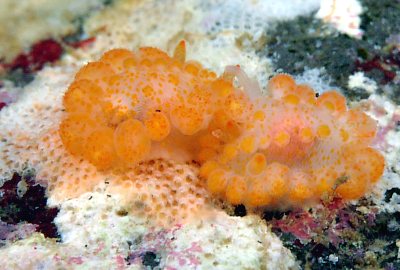
Dear Bill,
Here is a sea slug, Euphurus ornatus, which I observed in 2002, which I would like to contribute to the Forum. They are found on the underside of stones or the hollow of the rock. Theye were found at Osezaki, Suruga Bay, Japan
Upper Photo: 30 Apr 2002, Size approx: 6mm, Depth: 6m, Temperature: 19C. Lower Photos: 2 Jan 2003, Size approx: 5mm, Depth: 2m, Temperature: 15C. Photos: Jun Imamoto
Best Regards,
Jun Imamoto
http://umiushi.zive.net/
imamoto@wips.co.jp

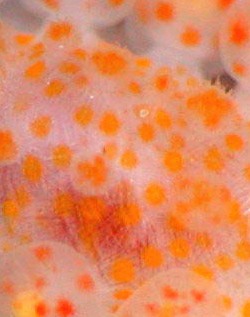

Dear Jun,
Thanks for these interesting photos. Although named Euphurus ornatus by Baba, it is now considered to belong in the genus Limacia, and to match that, E. ornatus becomes L. ornata. Your photos show the heavily spiculate skin of the mantle and the tubercles very well. I have included photos of the radula and an animal from Sydney.
Best wishes,
Bill Rudman
Radula of Limacia ornata
January 17, 2003
From: Bill Rudman
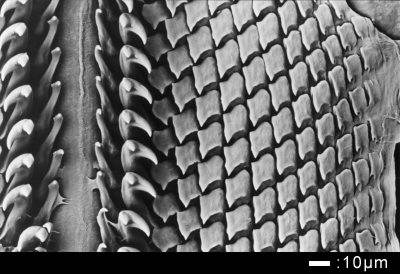
Here is an Scanning Electron Micrograph of the a section of the radula of Limacia ornata. The radula teeth are highly differentiated. The first lateral tooth is small, the second is large, bicuspidate like that of a polycerid, and the remaining eight to nine lateral teeth form interlocking pointed plates. Unlike some other polycerids there are no slender, recurved outermost teeth.
Data: AM C108290. Sydney, NSW, Australia, December 1977. Photo: Geoff Avern
I am trying to add a representative selection of SEM photographs of radula to the Forum. Until they are separately indexed, you can find other radula illustrations on the Forum by using the SEARCH button at the top of each page. Search for either radula or SEM.
Best wishes,
Bill Rudman
Limacia ornata from Sydney, Australia
January 17, 2003
From: Bill Rudman
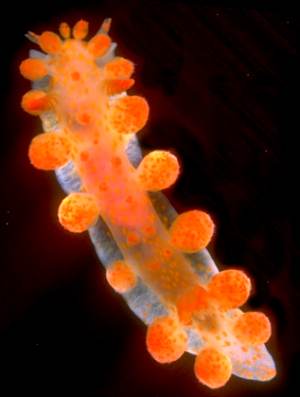
To accompany Jun Imamoto's message concerning Limacia ornata from Japan, here is a photo of an eastern Australian animal from comparison.
Data: Fairlight, Sydney, 15 November 1982, AM C136356. 18mm long alive. Photo: Bill Rudman
It is not particularly common, but it does seem to be a permanent resident in this part of the world.
Best wishes,
Bill Rudman
